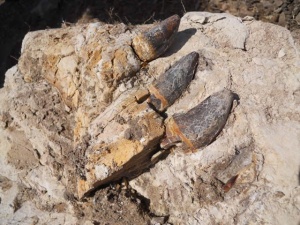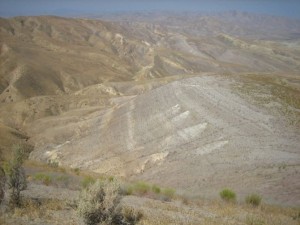The Moreno Formation
|
The Moreno Formation is Upper Cretaceous in age, and it is made up largely of organic-rich marine shales. It is part of a succession of rocks that are generally known as the "Great Valley Group" or the "Great Valley Sequence", and it is often, but not always, the oldest sedimentary rocks in the few places in the valley where it crops out. Exposures in the Panoche Hills that stretch all the way from Coalinga north to San Luis reservoir have yielded some interesting marine vertebrate fossils such as mosasaurs, as well as non-marine dinosaur fossils such as a hadradaur that probably got washed out to sea by an ancient river. Various terrestrial plant fossils have also been found that likely were washed out to sea by similar rivers. The Moreno has enough organic material in it in some places to be an oil source rock, and oils produced at the Oil City pool at Coalinga Field, and from some of the pools in and around the Raisin City field between Stockton and Fresno are believed to have been generated from the Moreno. However, these Cretaceous oils make up a very small percentage of the total oil production from California, and most oil produced in the state, possibly 85% of it, comes from the Monterey Formation. |
A Gallery of Pictures from the Moreno Formation
 Mosasaur teeth from the Moreno Shale |
 Moreno Shale outcrop in Panoche Hills. |
